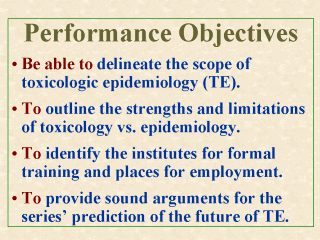| front |1 |2 |3 |4 |5 |6 |7 |8 |9 |10 |11 |12 |13 |14 |15 |16 |17 |18 |19 |20 |21 |review |
 |
At the end of
this lecture, students should be able to describe the definition and the scope, if any
concrete, of toxicologic epidemiology as a health science discipline. They should be able
to explain why in this series, health risk assessment (RA) is sometimes used
interchangeably with the term toxicologic epidemiology. For the second objective, students should be able to outline the strengths and limitations of toxicology versus epidemiology in RA, as provided by some other (more regarded) authorities in both sciences. They should be able to contrast the different perspectives regarding the role of epidemiology or toxicology in RA, if any, between this series of lectures and the literature. As a third performance objective, students are expected to be able to identify the type of institutes or academic departments that are likely to offer graduate degree programs in exposure assessment, RA, or a closely-related field. They should also be able to identify the various places where these graduates can secure employment in these areas, and the related recruitment issues. Finally, students should take the initiative to contrast the series' prediction with their own regarding the future of toxicologic epidemiology. They should be able to provide some sound arguments to justify both the series' prediction and their own. They should also be able to list the administrative nutrients that are fundamental to a good practice of toxicologic epidemiology. |